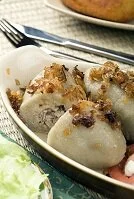Regional Variations & Specialties
Saltibarsciai: beet soup that is served chilled and takes on a bright pink color
Koldunai: stuffed dumpling like Poland's perogi
Dining Etiquette

Potato dumplings
Dining in Lithuania is respectful, but informal. Instead of hard-fast rules, etiquette is more based on respect and politeness. Unlike many southern European countries, dining in Lithuania isn't an overly social event.
Before seating yourself, many families have a regular seating order so let your host show you to your seat. After being seated, keep your napkin on the table and eat in the continental style (knife in the right hand, fork in the left). Also, take small portions at first, since you'll most likely be offered a second helping.
In some households, or more likely, on some occasions or holidays, dinner will be served with hard liquor, which should be drunk after toasts. The host will begin the toasting and you may or may not be invited to give a toast later in the meal.
When eating at a sit down restaurant with a server, you should round up or tip about 10% of the bill. In bars a tip is appreciated but not necessary.